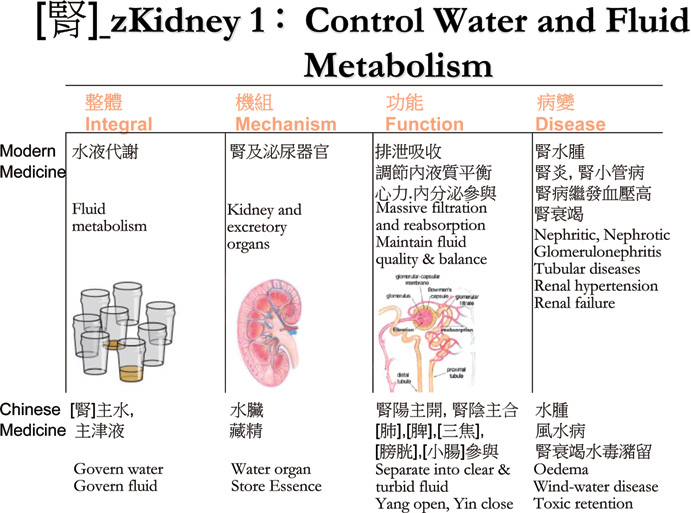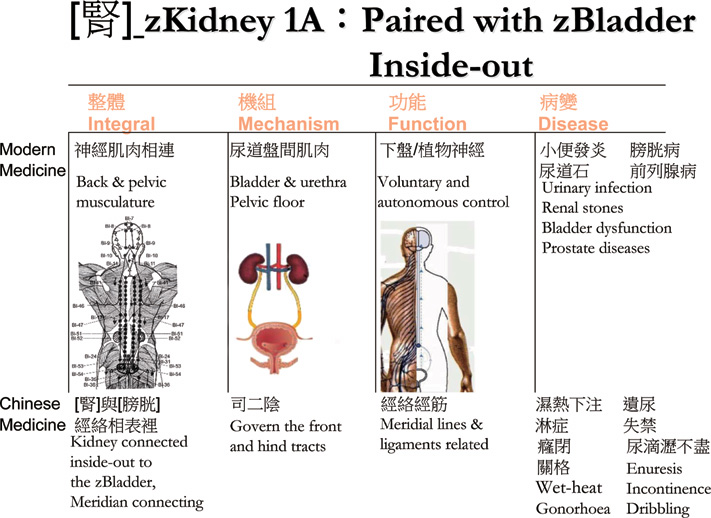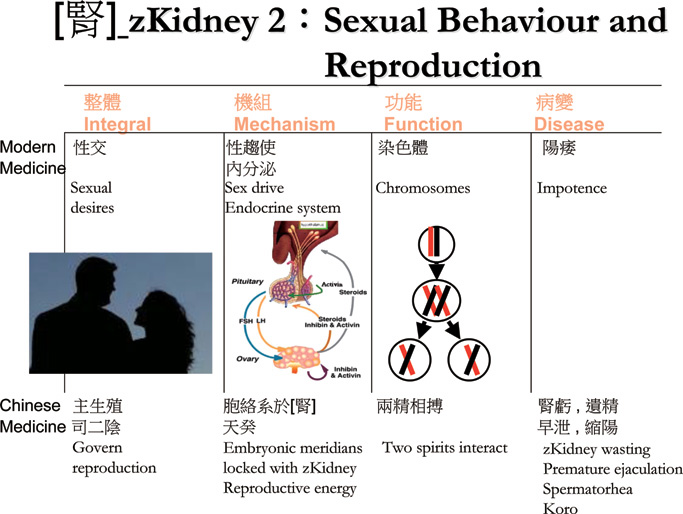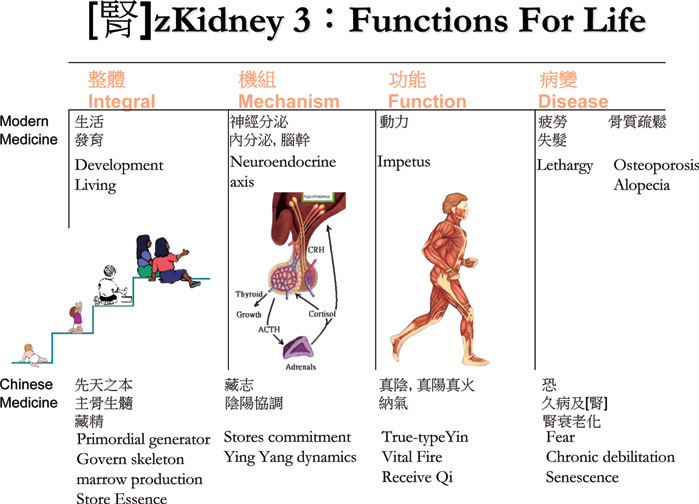
|
August 2007, Volume 29, No. 8
|
Discussion Paper
|
Understanding traditional Chinese medicine organs in the context of modern medicine - Part 1 : Zang Kidney*Edwin C L Yu 余秋良Edwin C L Yu 余秋良 HK Pract 2007;29:311-320 Summary This paper describes organs of Traditional Chinese Medicine on a platform that they can be understood by workers in scientific medicine. The zang kidney is discussed to illustrate that in the ancient Chinese, it could mean the same anatomical organ but with added dimension. Its meaning formalized by the zangfu manifestation theory in Chinese Medicine, may have added clinical significance to develop mainstream medicine. 摘要 本文以現代醫學角度陳述傳統中醫學的各種「內臟」。中醫學的腎臟,除代表解剖學上的腎器官外, 還有另外的意義。它在臟腑理論的涵意,或可有助主流醫學在臨床方面的發展。 Introduction The basic concepts in Traditional Chinese Medicine (TCM) have been previously touched on.1,2 Full translated accounts of TCM expressed in TCM language is quite available.3-5 The problem of different and almost non-tangible terminology of TCM language, caused by centuries of cultural differences,6 led to controversies and misunderstanding. Many papers promote TCM by justifying each point with science. The largest barriers to describe TCM mechanisms in scientific terms are the difference in language and lack of research. My objective in this series is to clarify in plain language what TCM means in its ancient context and in the context of modern science. Trying to bridge the conceptual gap between TCM and Western Scientific Medicine (WSM), my synthesized platform is used, being published more fully for the first time, to let TCM organs be understood in modern terms, without basing their understanding on Qi氣, Essence精etc, yet unrecognized and difficult to translate in scientific terms. Such will be explained in their TCM contexts in due course. Hopefully, the readers would develop insight for future medicine with more percepts and concepts. TCM organs in general TCM basically describes the body in terms of functional entities. On zang organs, TCM is more in a way describing a set of interrelated parts rather than one anatomical organ, and the zangfu manifestation theory臟象學說expresses the organ as generalization from physiological and pathological manifestations of the body systems. Even when anatomy was first understood sufficiently in ancient times, the body was said to be essentially constituted of only 5 zang solid organs and 6 fu hollow organs while other body parts are functionally related to them. (We'll later see a sixth non solid zang organ, the pericardium心包). The body then functions in its environment and varies with nature according to Yin Yang and harmony principles. Diseases may be due to perturbations of nature on poor body constitution and adaptation. TCM terms are often different from WSM terms. Thus, for the uninitiated, the TCM organs zang heart and zang lung may simply mean heart and lung. But zang spleen oddly means digestion and zang liver refers to mental control, while zang kidney refers to the kidneys and sex organs. Even with recent advances in understanding, zang organs are essentially different. The difference has led to divergent views on handling TCM words when confronted with modern science:- 1) They mean something totally different: same words used for different things. TCM used words of common usage to describe what lacked and should be technical terms. To quote "The organs themselves are characterized not by anatomical position but by a general function within the system as a whole that may not necessarily correspond to any western anatomical account",7 "Because TCM is holistic, each organ cannot be explained fully unless the TCM relationship/homeostasis with the other organs is understood."8 2) They are almost the same: same words used for similar things but different only in breadth. To quote "in Chinese medicine, the organs of the heart, lung .... are morphologically equivalent to the modern human anatomy and refer to the substantial internal organs of the same name. However, the explanation of their physiological and pathological manifestations differs greatly from those of the modern physiology and pathology".9,10 It has been common in Chinese e.g.寒 "cold", that the same word in another context becomes different and adds to the breadth and dimension of the word. 3) They are obsolete and should not be used: different (wrong) words used for same thing. Doubts on past errors in observation and the body poorly understood lead to controversy about the validity of TCM. The poorly defined relationship of TCM terms to mainstream medical and biological terms coupled with incomprehensible concepts causes many scientific workers to relinquish TCM terms and even TCM concepts. I leave these not discussed for the readers to judge until the end of my series of papers. In the meantime, a different wording may help. Note on wording My goal is to enhance understanding of TCM in more concrete terms, TCM words are marked with to denote that they are the same word but significantly different from modern WSM usage. Another recognised way in TCM texts is capitalising the first letter, as Blood, Liver, Heart, Spleen, Lung, and Kidney. For the sake of easier reading, I shall write them as xue blood and zangfu organs 臟腑 with each zang organ abbreviated as zOrgan (i.e. [肝]zLiver, [心]zHeart, [脾]zSpleen, [肺]zLung, [腎]zKidney).11 The zOrgan臟 in TCM are solid organs. They are called in ancient Chinese 藏 (cang, to store; zang, storehouse) to depict organs which collect and store. This is in contrast to the Fu 腑or zViscera which are hollow, through organ that receive and let through. In WSM the word organ means a list of fully differentiated structural and functional unit specialized for some particular function, while the word system is used to describe body functions with related organs. Elevation of platform With different paradigms along with all their implications, anomalies are difficult to be accepted by either side. Difficulties would be attributed to a lack of fuller understanding, inadequate technology, or the total different philosophy. But, the lack of progress can also be due rather to a lack of observations when such started on different frames of reference. My platform essentially sees TCM and WSM building up from the same biophysiological features of the body, only different when viewed from their own cultural perspectives. WSM started reductionistic, has evolved but lacks an integral view of the whole body adaptive behaviour. TCM started holistic but lacks a mechanistic view. Inspired from system theory, I hypothesize that integral, mechanistic, and functional views in one platform can pull these ancient concepts to modern medicine and will allow us to plainly see body and diseases in WSM and TCM. This would expand our probe for more useful observations to understand and utilize the TCM concepts. The zOrgans will now be described according to their integral, mechanistic, functional features and associated diseases. The zKidney, Zang Kidney The kidneys are located at either side of the lumbar spine, being "the home of the zKidney". To start with, the understanding of zKidney in TCM reads [腎]的主要生理功能是藏精、主水和納氣。對於人體的生長發育與生殖有重要作用,同時是人體全身陰陽的根本。 [腎]在體合骨;開竅於耳和二陰;其華在髮;在志為恐;在液為唾。足少陰腎經與足太陽膀胱經相為表。 [腎]在陰陽中,屬陰中之陰,五行屬水,是人體最重要的臟器之 一12。The zKidney includes both left and right kidneys. Thus, in TCM literature, the main physiological functions and features of the zKidney are: (1) storing essence, governing human reproduction, growth and development; (2) dominantly controlling water metabolism; (3) receiving Qi; (4) producing marrow髓 to fill up the brain (腦髓), dominantly controlling the bones, manufacturing blood (骨髓), its luster manifesting in the hair; (5) opening into the ear, perineal yin tracts (front-tract and hind-tract); (6) connects zKidney from the interior to the exterior with zUrinary bladder, with Meridians connecting. In short, the zKidney includes not just the excreting kidney. It basically includes the functions of the urinary system, reproductive system, part of the endocrine system and nervous system.13 Modern Chinese medicine had revealed that the zKidney includes the neuroendocrine axis. Working towards the ground that the ancient Chinese used the word morphologically equivalent to the anatomical organ of the same name but with added breadth and dimension, I believe that the zKidney refers to that one whole functional structure behind and below the peritoneum. Thus retroperitoneal and infraperitoneal organs including the suprarenals, renal, pelvic structures as well as the musculature are the zKidney. It would be easier to understand that the ancient people referred to one structure than lumping many disparate functional entities. That one functional structure serves important functions including excretion, sexual behaviours, and drive. In fact backache or discomfort is often associated with pathologies of all these functions. These may be separately described under 1. fluid excretion, 1A. related bladder function, 2. sexual behaviour and reproduction, and, 3. functions for life (Figures 1-4).
1. Controlling water and fluid metabolism Our integral body needs water, and fluid balance is essential to living. TCM sees the zKidney governing water and fluid metabolism. The kidney (in TCM or WSM) is the organ where all these are controlled. TCM called it the water organ. Functionally, the glomeruli and renal tubules maintain body water, electrolyte, and acid-base balance by massive filtration and then re-absorption, with the circulation dynamics and hormones supporting. In TCM, fluid is sent down by the descending function of the zLung to reach the kidney, where the Kidney Yang separates it into clear and turbid parts. The useful clear fluid (as Essence is thus produced) is returned to the lung and body, and the turbid waste fluid flows down into the urinary bladder to form urine, which is excreted. That sounds familiar. TCM fluid metabolism is complicated, saying that the zLung, zSpleen and Triple Burner三焦, zIntestine, and zBladder are involved. Let me detract from explaining these for the time being so as not to let readers lose sight from the momentum in understanding zOrgans. The zKidney functions to control the opening and closing the gate of water, i.e. excretion and retention of fluid, with Yang opening and Yin closing. The water gate, as its name implies, is also responsible for regulating the opening and closing of the two drainage yin tracts, namely the urethra and the anus. 1A. Related Bladder function The zKidney is connected from the interior to the exterior through the zBladder, meridian connecting. The kidney bladder excretory pair seems obvious. But this important pairing "相表" related inside-out concept is a concept difficult to understand in modern terms. Simply they work together. As in some zang organ pairs, their inside-out relations are not easily comprehensible, many modern workers retreat to ascribe pairing only by their linkage by meridians. But TCM actually ascribes something more. My platform will clarify this in the next paper on zHeart. The zKidney-zBladder is related also by muscular function. As retro- infraperitoneal organs and musculature are taken as one functional structure, the coordination of pelvic floor muscles by meridians and by autonomous and voluntary nervous control allow bladder functioning in concert with the urethra and pelvic muscles, and with the support of back muscles. To note, the zBladder meridian covers all the important back acupressure points. 2. Sexual behaviour and reproduction The integral body is born and developed with sexual desires, to reproduce and multiply. Sexual and birth activities are mediated by pelvic structures. TCM sees the zKidney dominantly important in reproduction. Modern understanding of desires and drives rests on the brain but is also related to hormones. In TCM, the female reproductive age is marked by the presence of Tianqui "天癸", heavenly thing, which is developed after puberty and exhausted after menopause.14 Open to interpretation, this certainly refers not only to gonadotrophins. It may simply be understood as reproductive energy. TCM also says that the embryonic meridians are locked in with the zKidney, and at reproduction the two spirits react with each other and form the essential substance. "兩精相搏為之神". Many take this analogy for female and male chromosomes interacting to form new genetic makeup. 3. Functions for life There are many, but long term development against weathering of the body through life may describe the main functions of life, and happiness/stress coping everyday may describe living. This is not a function of the modern kidney in any sense, and we have to totally rely on what TCM means. Somehow the strata of back musculature and adrenal functions for coping, and the reproductive hormonal system for development, are parts of zKidney. The zKidney is said to be the primordial power house that produce energy essential for the growth and development for the born body and activities [腎]為先天之本, in contrast to digestion which provides for acquired body energy. It dominantly affects the skeleton and marrow production 主骨生髓. The zKidney houses commitment 藏志, a consolidation of desires and drives as integral memory and will power. All these are mechanisms to support good life and living. The well coordinated dynamic balance of Yin Yang is needed for life. TCM goes further to ascribe residing in the zKidney a true type Yin真陰 with pure refined vital substance, and a true type Yang 真陽or vital fire真火as promotional dynamo or generator. Thus, the zKidney stores and provides the root of all Qi and Jing or Essence, the basis for all body matter. Don't laugh nor be frustrated to feel the ancient Chinese silly to include such seemingly irrelevant functions with the kidney. "Never frustrated, always inspired" may be a good attitude. After all, ask why the body should place adrenals suprarenally and not at other sites more naturally linked with related structures, like the ovary bordering the reproductive structures with its hormones related. Update investigation of Chinese Medicine theory has identified the hypothalamic adrenal axis an essential function of zKidney.15,16 Axis dysfunction correlates with zKidney deficiency in senescence, and with improved treatment outcome with zKidney medicine in different diseases including asthma and non-ovulatory uterine bleeding.17,18 The hypothalamic-pituitary-adrenal axis protects against stress. The adrenal epinephrine, norepinephrine, cortisol and mineral corticoids each have their function, but increased ACTH and cortisol increase stress tolerance. Studies to compare macroscopic parameters in neuro-endocrine-immune systems to microscopic parameters of T lymphocytes apoptosis and expression pattern of apoptotic genes demonstrated essential and intrinsic relationship between zKidney deficiency and senescence.19 Were the adrenals paired with the kidney and back musculature to cope with life in primitive life forms? Ancient Chinese, being life minded, might have watched various life dynamics and come up with these associations. My discussion on back muscles later may reveal a fuller meaning. Diseases and pathophysiology (Figures 1-4) WSM used to understand biochemical physiology and lesion pathophysiology. Renal dysfunction and glomerular inflammation and sclerosing or scarring disorders, as well as infective or functional urological problems are treated according to their lesions and pathophysiology. The TCM zKidney, with its wider context, would certainly mean a wider spectrum of disorders. Renal and lower tract related disorders include urinary frequency, enuresis, oliguria and anuria, seminal emission, impotence, premature ejaculation, infertility, and prolonged morning diarrhoea, rectal prolapse or constipation. TCM pathophysiology is discussed according to zangfu manisfestation theory. Essentially, zKidney pathophysiology talks about zKidney insufficiency. Recognized as zKidney deficiency, there are three types:
The main symptom complex includes back and knee soreness and weakness, teeth and hair loss, tinnitus or deafness, and impotence. Briefly, with insufficient space here, a zKidney Yin deficiency may manifest clinically as soreness, aching and weakness of the lumbar region and knees, blurred vision, and poor memory. A Yin deficiency with compensatory Yang over-reactivity will produce tidal fever, night sweating, dizziness, tinnitus, spermatorrhoea, and sexual dreams. zKidney Yang deficiency with decreased impetus show symptoms of lassitude, lumbar and knee pain and coldness, cold extremities and frequent urination, with diseases including inadequate reproductive ability, impotence, premature ejaculation, and poorly reactive cold uterus. Yang deficiency patients are associated with decreased cyclic AMP and increased cyclic GMP, while Yin deficiency patients have the reverse.20 The cAMP / cGMP ratio is often used as a Yin Yang marker. To note, cAMP facilitates cortisol production.21 Functional disorders without marked symptoms of heat or cold syndromes are considered to be a zKidney Qi deficiency disorder. Somatic disorders without cold or heat symptoms with symptoms of dizziness, ringing in the ears, soreness and lumbar or knee aches, poor bones and maldevelopment, are classified as zKidney-Essence deficiency. These are the TCM syndromes, but the distinguishing signs in faces, tongue and pulses are important. zKidney function also affects breathing, consequently asthma, and also menstrual function. Making diagnosis for all patients with the zKidney syndrome with a WSM disease, and treating them with zKidney medicine, the body will improve and the patient may get better. But a TCM practitioner who does not understand life, its resources, forces, entropy, weathering, and Yin Yang dynamics cannot treat patients well. Confronting with modern medicine For different diseases like asthma and non-ovulatory uterine bleeding, treatment by zKidney medicine may improve outcome. Does understanding zKidney help treating renal diseases? TCM can be useful to supplement WSM treating renal disorders. However, the zKidney is not kidney and does not provide a clear picture as modern renal pathophysiology. This is also not the area to look for wonder drugs like Tripterygum wilfordii雷公藤, since treatment with the zKidney concept is only part of the zangfu manisfestation theory on overall interrelation of body functions. In fact, it is usually the other concepts in TCM that help treating glomerular disorders, which are immunologically related. But functional disorders are better treated. Urological disorders and problems that are musculature related can be treated, like incontinence, and enuresis with zKidney deficiency. Proteinuria sometimes can be treated by adding zKidney medicine as this is related to zKidney deficiency, but sometimes need additional medicine to activate circulation and remove stasis活血祛瘀to promote angiogenesis. Particularly, sclerosing glomerulopathies analogous to hastened ageing can be remedied by adding zKidney medicine which is good for senescence. It does help muscles. In fact back and lower leg muscle and bone problems associated with zKidney deficiency by definition can be remedied with zKidney medicine. The back and pelvic musculature form one important functional group. These are the postural muscles for coping. Kungfu calls for force and power originating from the lower back at the Dantian丹田 sacral chakra level and for committing power for kungfu dynamics. This area also receives the most important Qi 納氣, explaining this mechanism of the zKidney through these muscular coordination. They are also muscles for courting and mating, and muscles coordinating the two perineal tracts, urethra and rectum. Typical of female quadrupeds, e.g. rats, a lordosis behaviour, which is a standing response coupled with a strong vertebral dorsiflexion, is a must to allow the male to fertilize. Triggered by cutaneous contact by the male on crucial skin areas, it needs the oestrogen and progesterone-primed hypothalamus, the same area for stress, to massively activate the vestibulospinal and reticulospinal tracts controlling the large back postural muscles.22 Lordotic dance is still a sex appeal in human. To note, stress and sex mutually inhibit. Interestingly the adrenal gland and ovary are placed along the back! zKidney medicine is effective particularly for treating the back postural muscles. The point about Yin Yang is used to help determining which type of zKidney medicine to use. Final remarks Reductionistic at one time, WSM previously placed the musculature out of the discussion of body systems. The retro-infra peritoneal organ mass of adrenal, kidney, ovary, uterus are related to reproduction, excretion, mating behaviours, and stress tolerance. They form one piece of functional structure with the back and pelvic musculature and the perineal tracts for coping, courting, and commitment dynamics of life and living. Over former workers, I hypothesize that this one piece is the functional structure that ancient Chinese called zKidney,23 which interaction with the neuroendocrinal axis forms an intricate mutually interrelating supportive complex. This matrix-functional complex may have a basis from primitive life chemistry and forms. WSM will take a long way to re-understand interactive body masses in its molecular language. Modern medicine may need to take a further step to increase understanding the method of clinical assessment and significance in this direction. Understanding of the zKidney, as one of the zangs, may provide a way to understand a complex adaptive system of the body as well as another view on assessing and managing the integral body. Key messages
Edwin C L Yu, MRCP (UK), FRCP (Glasg), FHKAM, RCMP
Honorary Professor, School of Chinese Medicine, Hong Kong Baptist University. Correspondence to : Dr Edwin C L Yu, c/o INTEMED H.K., Room 1901-03, Chung Kiu Commercial Building, 47-51 Shantung Street, Mongkok, Kowloon, Hong Kong.
References
|
|



